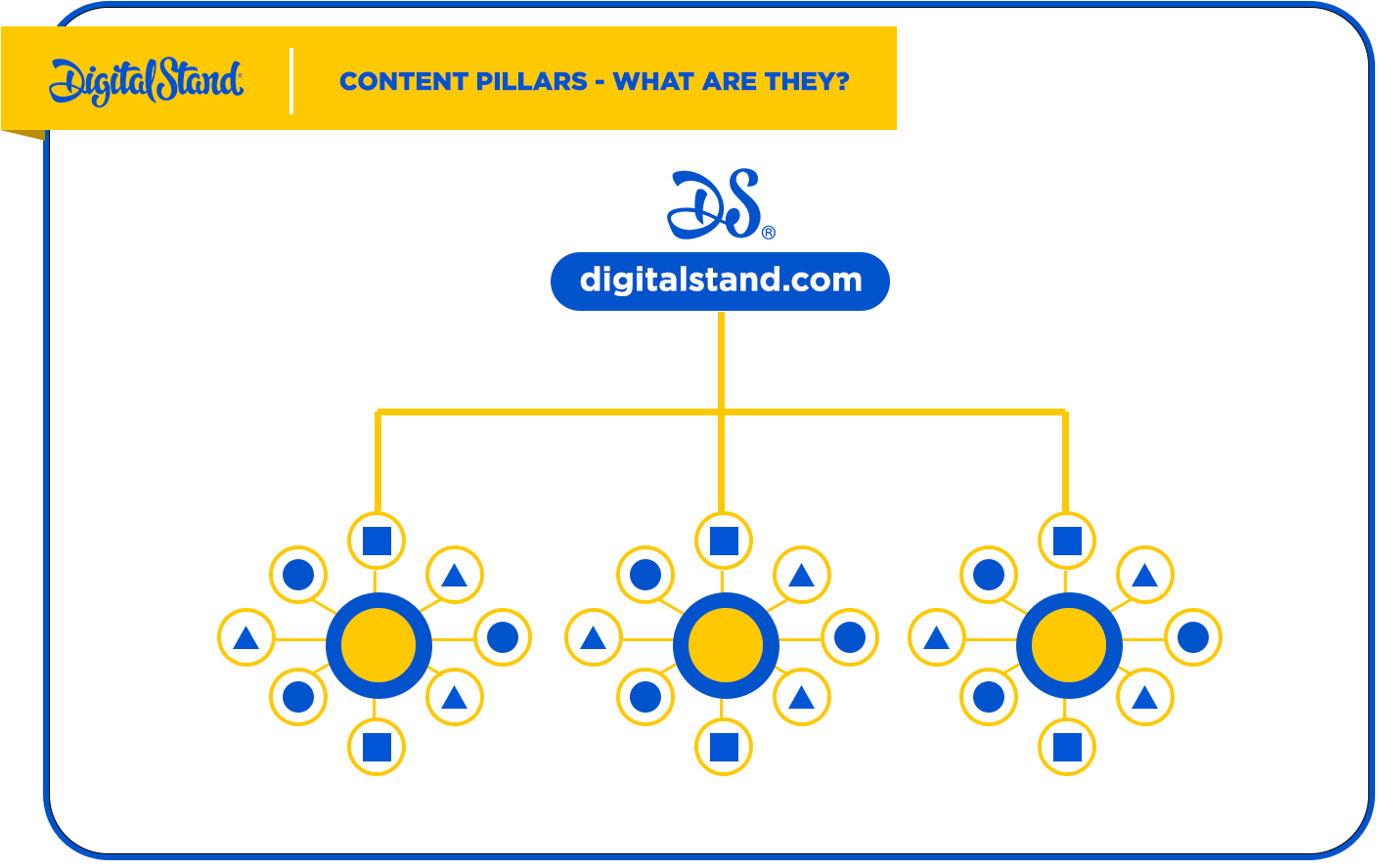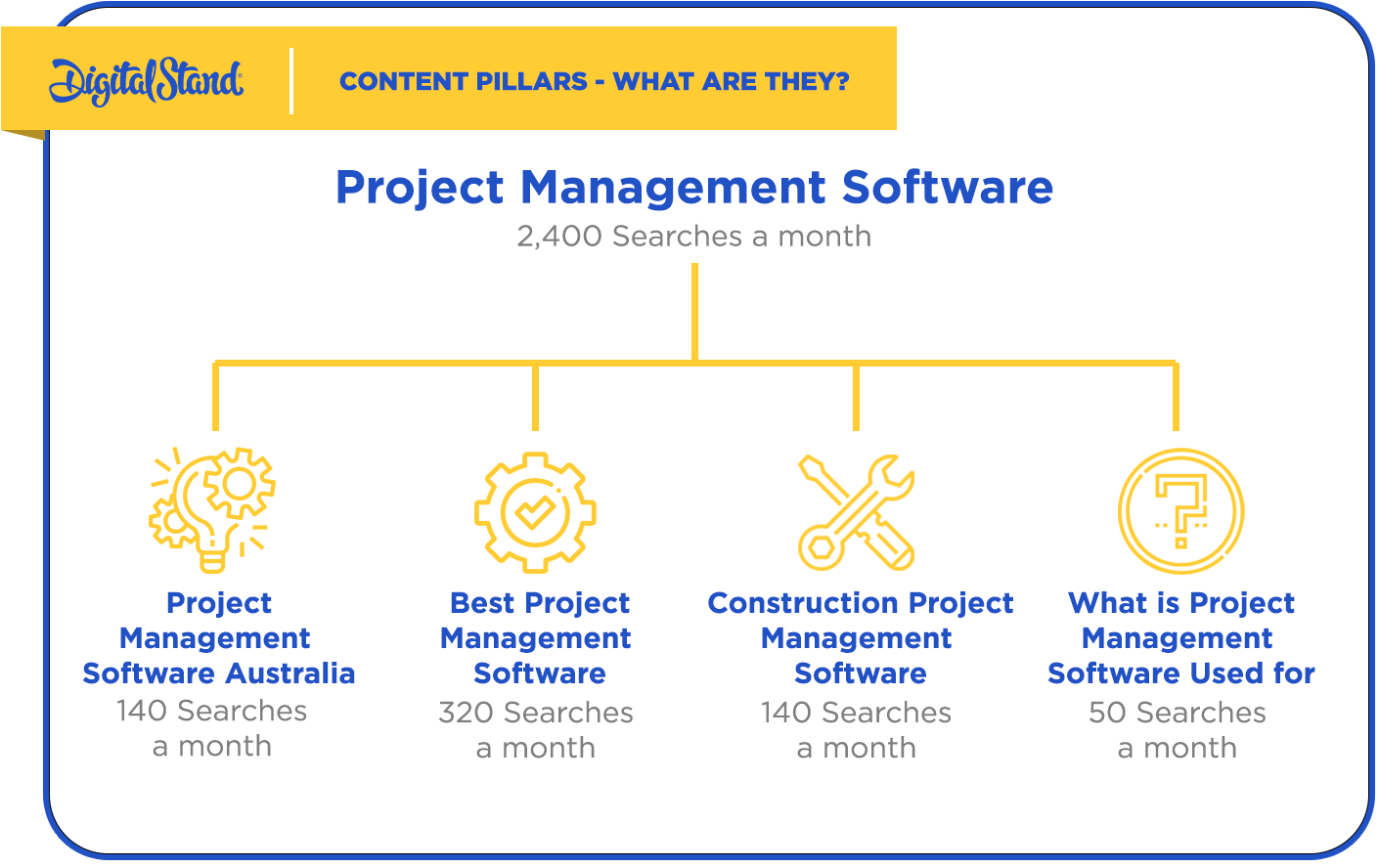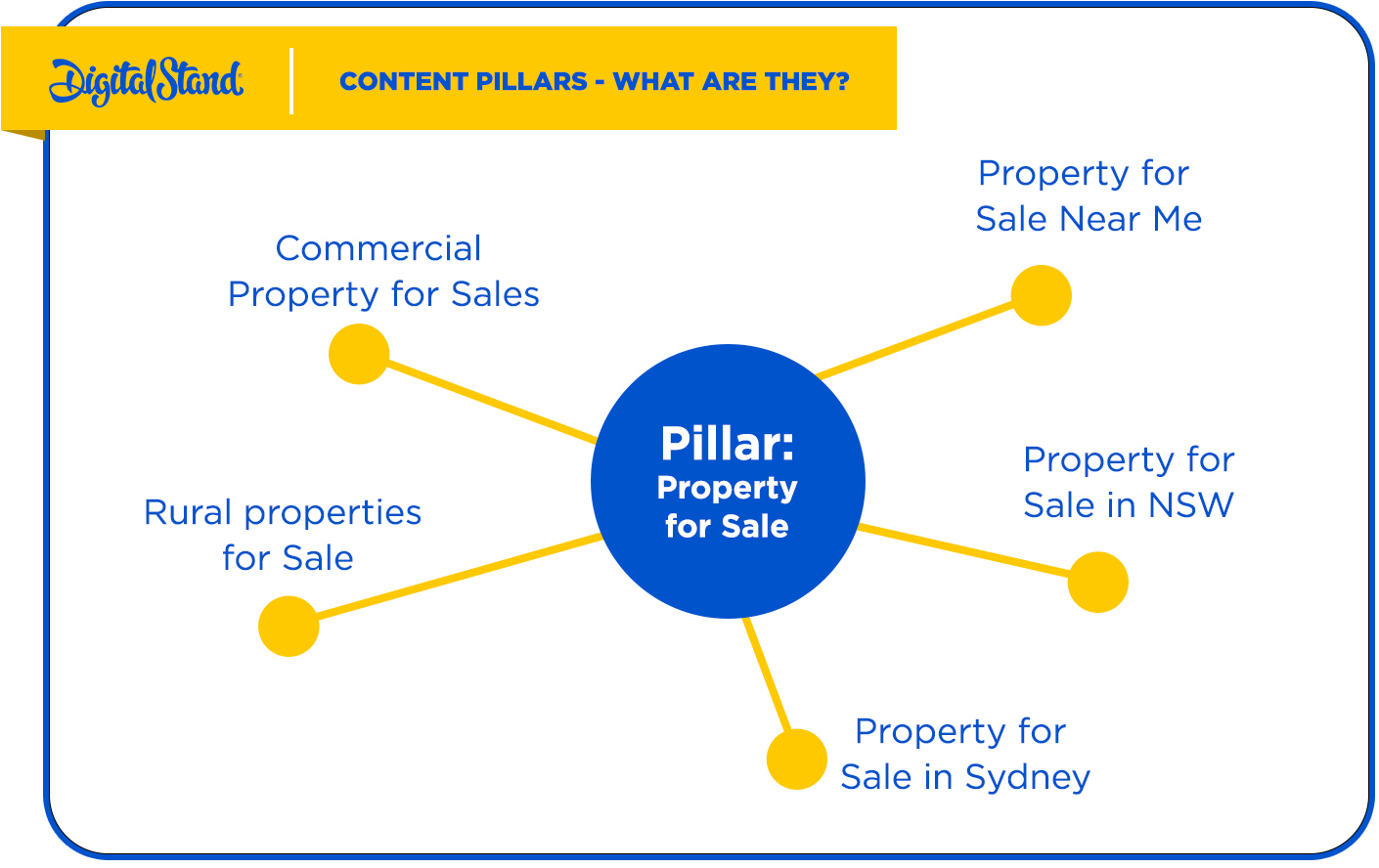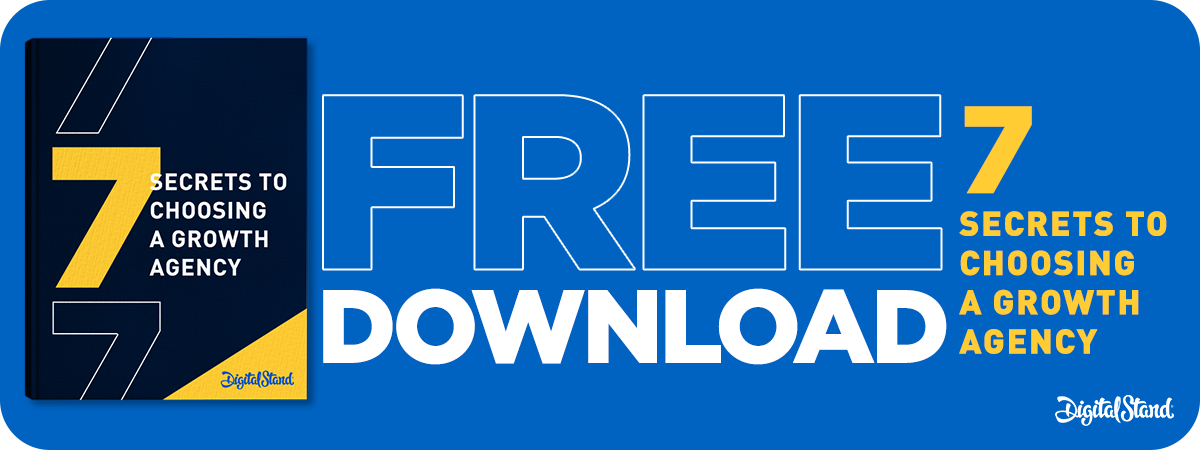Content pillars provide you with an unfair advantage when it comes to SEO.
Content pillars are an authoritative piece of content that educates your audience about your subject matter expertise.
Typically, they will have several subset areas that you can elaborate on—the core subject educating both your audience and potential clients with an informative piece of content.
They are designed to have a strong relationship with search engine optimisation (SEO) and drive traffic and awareness. It is a strategic way to think about your content if you're looking to rank higher in Google.
As you would know, the Google algorithm concerning search is continuously changing. Google has been making significant investments in machine learning and artificial intelligence. This has included the introduction of RankBrain into their core algorithm.
The purpose of RankBrain is to understand the searchers intent. When it comes to search and ranking on the first page of Google, we (you and me) also need to think about the searchers intent. Apologies for stating the obvious. Let's move on.
Because it is an alignment of your content marketing strategy.

Using the above example as a guide, I typed social media into the Google search engine. Consequently, Google brought up a whole range of areas relating to social media. As you can see, Google shows me areas related to my search that I might be looking for as it is trying to guess my intent.
Possibly even showing me areas that I had not considered as part of my search string but are relevant to my area of interest.
Why Are Content Pillars Important?
Content pillars or pillar pages are important because they allow you to structure your content creation. You can do this by searcher intent and what it is that you want to be known for.
At Digital Stand, we often engage with clients who have been creating content but want to know why it isn't ranking for Google search.
The reality is that often the science is not applied to the content structure. Without science, very seldom are you going to get the result you are seeking.
No question creating content on your website or blog posts for that matter is essential and will help with search discovery.
Although you must plan your content to be strategic.
And it must be the subject matter you want to be known for and something that you're competent in.
As a pure-play social media agency with deep inbound marketing capabilities, these are the areas that Digital Stand wants to be known for.

Original concept HubSpot
This means our content is structured and works well for searcher intent, and shows our expertise in these areas. While I won't go into this in detail in terms of SEO, I will give you an overview of how one might go about this from a more strategic perspective.
Now, if we take a broad subject like "social media," we may want to be known for that term, but we might not?
To put this in perspective, the term "social media" has a search volume in Australia per month of 18,100 queries. While this would be an excellent term to rank for, the searcher intent may not match our purpose.
On the other hand, if we're trying to rank for the term social media agency? Which has a search volume of 1,300 searches per month. This will not only match the searchers intent but our purpose.

As you can see from a slight change to the context, it fundamentally changes how Google responds.
You may ask why we don't want to rank for social media? And that is a very valid question. The fundamental reason is that it is such a general search that, as an Agency, we don't understand the intent. Nor do we know the nature of the person searching.
Also, such a broad term search is likely to be picked up by organisations like Wikipedia. From a digital authority point of view, this means it's tough for us to outrank a site like Wikipedia.
And even if we did, it might not be worth our while. However, turning up on the first page of Google for the term social media agency is worth our time and makes a lot of sense!
So this may well be where we want to start when it comes to creating a content pillar. It does not matter what industry you are in, Computer Software, Higher Education, Property Development, Real-estate, or E-commerce.
This principle holds across all industries, B2B, and B2C.
What does a Content Pillar Structure Look Like?
A content pillar structure has the main subject in the centre and all related subjects connected to that primary subject. And then, of course, the main content is linked to the homepage of the website.
In the above example, we might choose five core areas that we want to be known for. We would then break those core areas into subsets that relate to each of those points.
For example, you might want to be known for "project management software." As a subset to that core content, you might also want to rank for the term "best project management software." And for "construction project management software."
When you set up this pillar content for the term "project management software", you want to make sure that this is an authority piece of content that talks to this subject in a comprehensive way.
You would then create subset content below this that is also authoritative. It might not have the same search volume as the term "project management software" mentioned above, but it still adheres to your strategy.

Of course, if construction is your industry, this makes sense, but it is also easily interchangeable with whatever industry the project management software company is in. This approach also lets you identify new industries that need your services or offering.
As you know, with search, we all search differently, and Google often presents us with different content.
The buyers' journey is not a straight line, and someone searching for pricing might be closer to a buying decision.
While someone looking at project management software might be looking to understand what the options are.
These two buyers are at different stages in the buyers' journey but are also relevant to your business if you're selling project management software.
Irrespective of their journey, you want to make sure that you're turning up and ranking well for those terms.
By aggregating your content in the manner above, you signal to Google that you are a thought leader and you know your subject matter.
Having said that, though, you do want to make sure that you're creating informative and helpful content.
You want to keep the reader engaged on your page. By keeping the reader engaged on your page, you're also helping Google! Yes, their intent is to serve the most informative content to the reader in the shortest amount of time.

And by doing so, you have matched the searches intent, Google's desire, and your goal.
How to Pick Content Pillars
Sometimes picking a content pillar is straightforward, but sometimes it is more complex. You should start with five to six subjects that you want to be known for.
It would help if you then researched these subjects identifying the search volume related to those areas. And of course, analysing if you can compete?
There is no point in ranking for content that no one is searching for. Or that you cannot rank for.
The best way to think about this is what you want to be known for and the problem that your target audience has that you can solve?
An example could be the following:

Now all these keywords have a relationship in terms of content that you can create. However, it is essential to note that they are all separate search terms and deserve their own content.
You would want to create an authority piece of content such as "property for sale", then link all the other pieces of content in a hub and spoke model to that core piece.
By doing this, we're solving for the searches intent and creating a series of related content, helping them at every stage in the customer journey.
There are many ways that you can derive the areas that you want to be talking about:
- It could be as simple as looking at the questions you most commonly get asked in terms of RFP's?
- Or the core set of products that you sell and the questions that people ask about them?
- Or the problems that people are trying to solve for such as how to get fit fast?
Making sure that you're writing valuable content that answers the searches query. And that it has a relationship with your business and the additional content you will create.
Types of Content Pillars
Depending on the size of your organisation, you might have several business units solving different problems. For example, your organisation might help sales enablement, marketing strategy, and service delivery.
If this is the case, you want to create several content categories with a supporting blog for each.
You want to isolate each subject area from the next to show in-depth expertise in those areas. While also creating a relevant content journey path for customers looking to dive deeper into each subject matter.
Content Pillars for Social Media
You can, of course, extend content pillars to your social platforms and distribute content that's relevant on this basis.
This is a great distribution channel for your content to demonstrate expertise in your subject matter.
Creating content pillars on your website with in-depth content and then distributing it on the social network is the perfect push-pull model.
On the one hand, you're looking to turn up in discovery when people are searching organically. And on the other hand, you're pushing the information out for those who are a little more passive in their search.
You can create content pillars for Instagram, LinkedIn, YouTube, and of course, Facebook.
Content Pillars and SEO
When you create in-depth pieces and related content, you send a powerful signal to Google.
When it increases engagement on your website, creating longer session durations, and in turn, creates a strong signal about your authority.
This, in our opinion, is the best form of SEO because it is evergreen, it is adding immense value, and demonstrates your expertise.
Content Pillar Examples
At this point, you're probably wondering what some content pillar examples are? And how you or an agency like Digital Stand would be able to execute a content pillar strategy for your brand.
Rather than spend a significant amount of time showing a wide range of different examples, I'm going to show you the very best!
The first is from Typeform.
If you dare click through to the link, you'll see that reading this piece of content around brand awareness will take you 44 minutes.
Then there was this content pillar on Artificial Intelligence.
Or this one just released from Apple
And, of course, at Digital Stand, we also practise what we preach.
Summary
So the next time someone comes to you telling you that they can rank you on the first page of Google. Ask them if they know what pillar pages are, content buckets or, for that matter, a content pillar strategy.
If they cannot answer your question, all they have are tricks that might get you a short term result, or for that matter, no result at all!
The reality is that you cannot trick Google into a first-page result.
You can, however, create valuable content the people are searching for daily. That helps Google answer their questions in an informative way.
This works for everyone concerned! For the searcher, the search engine and your brands content.
And when you solve their search problem, you, in turn, solve yours.
At Digital Stand, we have been creating quality content for almost ten years. Achieving above industry benchmarks in every respect.
If you are interested in understanding more about us, you can contact us here for a no-obligation conversation.
If this is not the right time, please feel free to download the content calendar below. Please note if you do not see it below refresh the page and it will magically appear.

.jpeg?width=200&height=200&name=pexels-mikhail-nilov-6893349%20(1).jpeg)


.jpeg?width=318&height=135&name=pexels-cottonbro-studio-4065876%20(1).jpeg)






